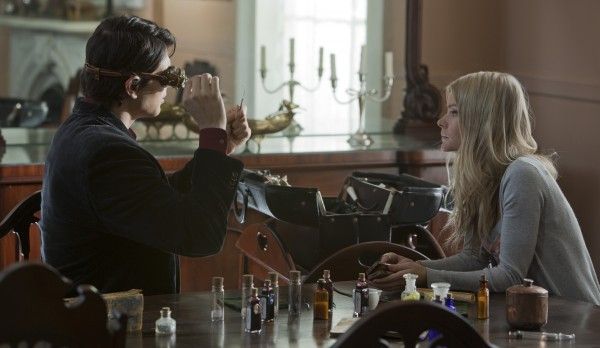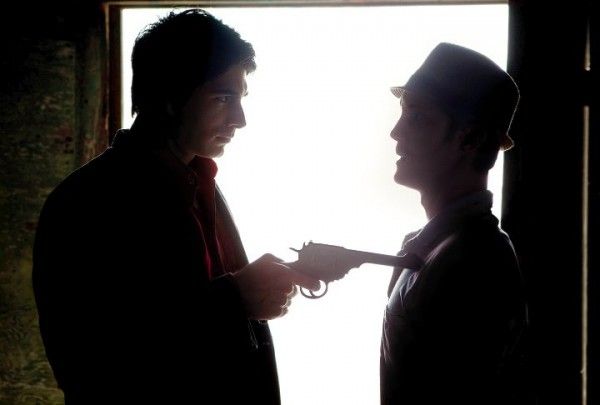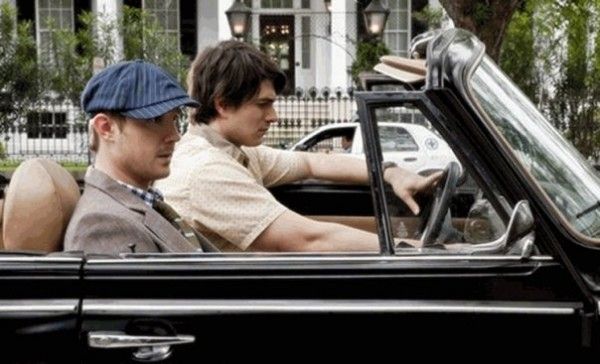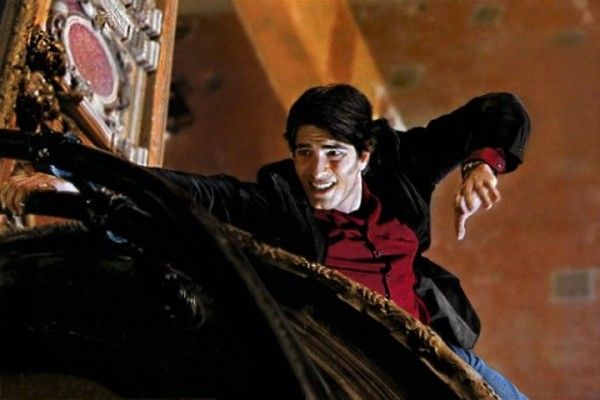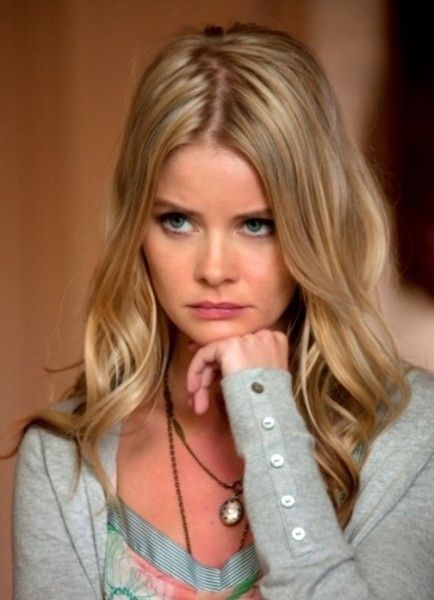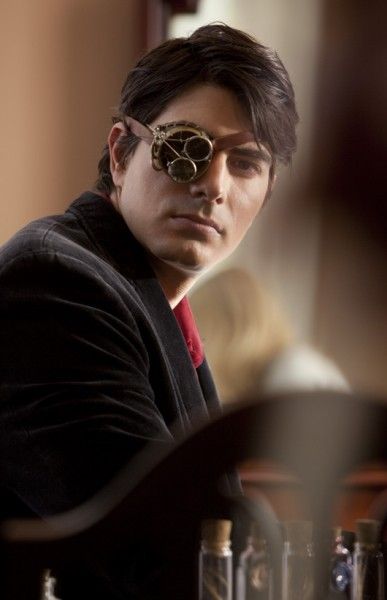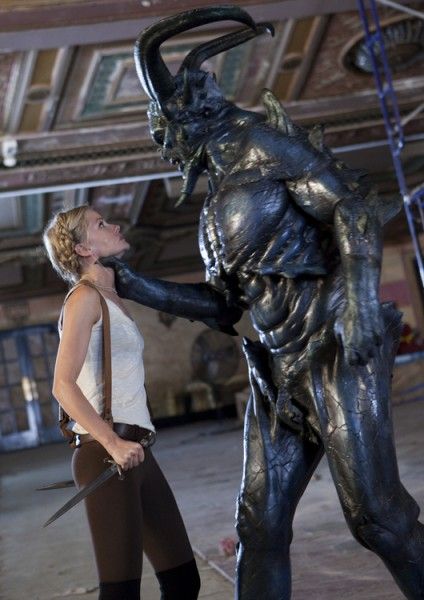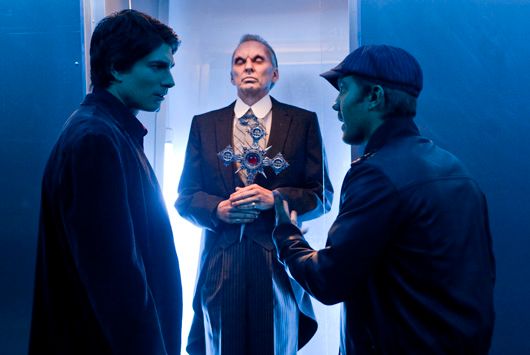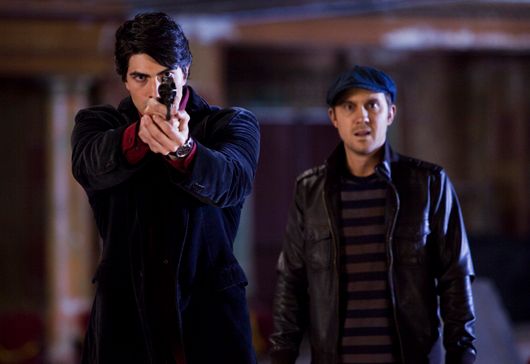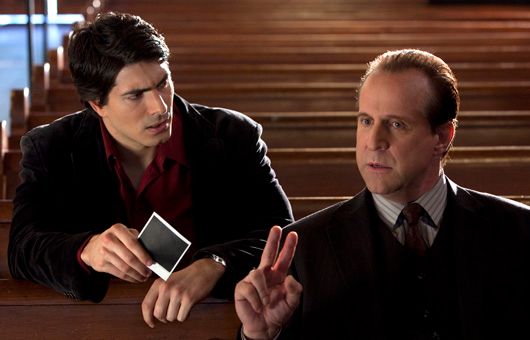Although Dylan Dog is director Kevin Munroe’s first live-action feature, his background in developing comics and his love for the story made him the perfect choice for the job. Blending horror with comedy, the film tells the story of a private investigator who gets drawn back into the world of the undead when a mysterious woman (Anita Briem) asks for his help on a case. To make matters worse, his assistant Marcus (Sam Huntington) gets turned into a zombie, and Dylan suddenly finds himself caught between warring vampire and werewolf clans.
During this exclusive interview with Collider, Kevin Munroe talked about how he first came across the story of Dylan Dog, changing the melancholy tone of the comics in favor of a more humorous feel for the film, why it’s been such a long journey to the big screen, what made Brandon Routh and Sam Huntington perfect for their roles, the decision to use practical make-up for the creatures, and how he would love to do a sequel where he could explore Dylan’s roots back in London. He also talked about the project he is currently working on for LucasFilm, and how both of his comics – El Zombo and Olympus Heights – are currently in development for film and television, respectively. Check out what he had to say after the jump:
Here is the synopsis:
In the world of Dylan Dog, monsters are secretly living among us. Dylan is the world’s only private investigator of the undead, and he will go where most living dare not, facing down friend and foe alike, until justice is done. While he knows all of their underworld secrets and rivalries, Dylan is also increasingly convinced that, like any normal person, the less he has to do with the undead and their myriad problems, the better. However, someone or something always drags him back into the dark world of the undead.
Question: How did this project come to you?
KEVIN MUNROE: I was developing a comic book at Dark Horse Comics in the late ‘90s, and they were just translating Dylan Dog into English. I picked it up and read it, and I thought it was really cool. It was about a detective and there were monsters, and I just really loved everything about it. Then, I went away and did another movie, and started developing another one that fell apart, and then a producer friend of mine sent me a script and said, “They’re trying to find a director for this movie.” It was called Dead of Night. So, I was about 10 pages in and I was like, “Wait a second, this is a Dylan Dog movie.” I called him up and he said, “Yeah, we just changed it because everybody thought that Dylan Dog would sound like Deputy Dog or underdog, or whatever.” So, I read it and 10 minutes later, I called him up and said, “I just have to do this movie. It’s really good. Tell me what I have to do.” So, I pitched my guts out and danced all around the room and found someone crazy enough to say yes. It was great.
How difficult was it to persuade them to go back to Dylan Dog for the title?
MUNROE: That’s a good question. It was really hard. Even when we started shooting, it was still Dead of Night, and the chair backs that we had all had Dead of Night. It ended up being a good cover name for everything, which was great. Batman and Spider-Man are just as silly. Those names are ridiculous. But, when you think of Batman, you think of Christian Bale, who’s bad-ass. So, we needed an icon to be able to put next to this iconic name. At Comic-Con in 2009, we had a little sizzle reel with this big flurry of action, and then ended with a really bad-ass shot of Brandon and we faded to Dylan Dog, and everybody was like, “I get it now.” The producers were leaning that way, too. Everybody wanted to change it. It was going to get released as Dylan Dog anyway in Europe because that’s just the higher selling brand name.
Did you have to be aware of the fact that most of the audience in America won’t know this comic book when they see the film?
MUNROE: Oh, yeah, that’s totally the way we did it. I didn’t want you to have to be a fan of it at all, to be able to follow it. I want you to be able to watch the trailer and go, “I get that.”
Were there specific things you had to change, in order to make sure certain things got across to the audience?
MUNROE: The melancholy tone of Dylan was something that I pulled back on a little bit because I do think there are better ways to entertain an audience for two hours. There were details that were changed, such as it being a black Beetle instead of a white Beetle, and his sidekick isn’t Groucho Marx, like it is in the Italian comic book. They all had their individual reasons, and they were all legal or financial. But, for the most part, anytime we could stay true to it, I wanted to be able to. When you see Dylan playing the clarinet, every Italian fan knows what that means, but to someone who doesn’t know the comic book, they’ll just think it’s odd. I didn’t want anything from the comic book to trip you up while you were watching it.
Why did this take so long to reach theaters, after it was finished?
MUNROE: Going from CG to live-action, I was like, “This is great. We’ll prep it for two months, we’ll shoot for two months, I’ll edit for six months, and then it will be out.” And then, it ended up being just as long as a CGI movie. It’s so purely the spirit of independent filmmaking. It’s just a bunch of people getting together, who all have a little bit of money and all say, “We want to see this brought to screen.” The length of time is what happens when you go and shoot a movie without having distribution locked. It’s just one of those things. Everyone does it. The good thing was that we did find someone who was really passionate about putting it out. But, it’s what the creative freedom of not having a studio and not having distribution buys you. It’s that double-edged sword. You get so much more freedom because you don’t have a studio screaming, “Where is it?!,” but at the same time, you’re on your own after the movie is finished.
Did you ever worry that it wouldn’t come out, or were you always confident that things would work out?
MUNROE: Before the movie got greenlit, I struggled for a year or a year and a half. We were going to shoot it in Toronto, at one point. When you’re developing stuff, I know that it’s real once I get the check in my hand, or when I show up on the first day. Even then, it’s not real sometimes. I’ve had deals where they pay you and then change their mind. I wasn’t really worried, but I had my doubts, every now and again. And then, as soon as it got greenlit, we blew through production and everybody just knew it was going to be a really fun movie. When they start showing it to studios, that’s the point where you start hoping that people see what you see. Whenever the big studios looked at it, they wanted to see Constantine, and we specifically didn’t make Constantine or Underworld. It was just a matter of finding those people that really dug it and got this kind of a movie.
It is a miracle that anything gets made. It’s not for the faint of heart, at all. You could so easily get really depressed or really down about the whole thing, but you just don’t. You have to do it for the joy of making it. Even then, I knew I shot this great movie and I was really proud of everything that’s in it and how it was done. Distribution – if it’s on 50 screens or 5,000 – was not going to change that. You also move onto your next project before the last one comes out. With Ninja Turtles, I really tied a lot of my emotion in with the opening. It won the opening weekend and made a $100 million, but I tied more into my future with that opening and it put a lot of pressure on it. I just try to avoid that now.
What did Brandon Routh bring to his role, and what did Sam Huntington bring to his role, that made them perfect for this?
MUNROE: Brandon had a strength when he wasn’t saying anything, and I really like that. I gravitated toward that because that’s the way the comic is. It’s a very pensive comic. While I didn’t want to do Leaving Las Vegas and have two hours of that, I wanted you to look at the character and go, “I get that that comes out of that head.” And then, Sam was perfect for the role because he’s constantly pushing Brandon and testing him. He does that in a way that only your best friend can. There are things that you let your best friend get away with that you don’t let anybody else get away with, even a spouse. That’s how they are. They just have this rapport. And, on top of that, Sam brings so much energy.
Was it challenging to find the right girl for the film, to balance Dylan and Marcus?
MUNROE: Yeah, it was a real challenge. We met with a lot of actresses, and then Anita [Briem] came in and was really excited about the role, and she got the whole angle to it. It was a really meaty role for somebody who wanted to bite it off and make it their own. Anita is so strong on screen. She has a great action hero face. She just has this glare about her. And, she really got into the stunts. It was crazy. We went through quite a few prop knives with her. She was very excited. It was really cool. She really gave it her all.
How did you get Taye Diggs and Peter Stormare to do the film?
MUNROE: Peter is a cool dude. He’s really fun. We called him up for the role of the head of the werewolf clan. We were trying to really cast everybody according to type, so all the werewolves are very working class, dock worker types. I love the idea that their eyes were really focused, and Peter has this real focused face. We talked and he really loved the role and he said, “Of course, I’ll come down and do it.” His wife was almost going into labor, but he came down for the three days and was such a good sport about it. His only caveat was that, if he died, he wanted to make sure that we didn’t imply that he was gone for good. There is actually a deleted scene where we see Peter come back from the dead. It was really funny. It was interesting because he’s a werewolf, but he was killed by the zombie who was being fed vampire blood, so that’s three monsters in one. When you think about it, genetically, what could he become? I would love to bring him back. That would be fun.
And, Taye was great. I called up Taye, and he and his manager were both really into the idea of him being a villain. He’s just got that smile and everybody melts. So, I was talking to him about it and he said, “I just don’t know if I can do the whole villain thing. Do I have to act meaner?” He and Brandon are the two nicest guys ever in Hollywood, so to get them to try to get mad or kill somebody, you have to play mind games. I was like, “No, you’re going to kill someone, and then turn and smile and flash your little gold tooth fang, and everyone is going to melt, but they’re going to go, ‘That guy’s psycho.’” And, he got it. He totally fed into it. He came up and got to wear Versace every day and act all cool and kill people. It was great.
At what point did you decide that you were going to mostly use practical make-up for the creatures, and how does that affect the performances of your actors?
MUNROE: My first pitch about directing the movie had all practical effects in it, and that was when the budget was much more. If I had had more money, I would have just put more people in suits in the movie. I wouldn’t ever have gone to CG, for that stuff, specifically. I’m just a fan of those movies, and I think it’s cool that the actors have somebody to react to. When a guy who’s seven and a half feet tall walks in the door, and he’s bigger than Brandon, it just sets the tone for the room. There’s a reality to it, and there’s also a humanity to it, too. As I’m doing more projects and trying to start a career, I’m realizing that I love when you take bizarre, non-human things and somehow make them human or accessible. I think that’s why I like the practical effects. You can look at a creature and still see vulnerability or the character behind the creature. To get character behind CG creatures, that’s so few and far between.
Did you have any favorite creatures, or ones that you were most excited about bringing to life?
MUNROE: I really love the tattooed zombie. I sketched up that one a lot and I really liked that design a lot. I was really excited about him. I was all giddy, whenever he came out. I thought it was really neat. Also, I love the Bilal character at the end.
At the same time you were filming, were you thinking about what you would want to include on the DVD/Blu-ray release?
MUNROE: You just naturally amass it. I never did anything specifically for the DVD, but I knew there was always going to be more than what is in the theatrical release.
Does that make it easier to have to cut stuff out of the film?
MUNROE: I’m sure, yeah. I can’t imagine what it would have been like in the ‘60s or ‘70s when you were cutting stuff and it was like, “I cut this piece of film out of this reel-to-reel that I’m editing on and that footage is gone.” It’s archived, but it’s not sitting there. That does alleviate a lot of your concerns, whenever you cut something, because it still has a way to be seen by the public.
What did you find most surprising about making your first live-action feature?
MUNROE: Everything was a surprise. It was surprising how addicting it was. I love the pace of it. That surprised me the most. You just show up and it’s such a well-oiled machine. Everybody knows what they’re supposed to do and they all look to you to be the person to say, “This is where we’re going,” and all of a sudden, 200 people just go that way. I was really surprised with that. Animation is so much slower that you don’t really see that wheel house.
Are there things that you learned about the process of making a live-action film that will make the next live-action project you do easier?
MUNROE: I think, for the next one, I would not be as married to locations and ideas, when I show up in the city that I’m actually going to shoot it in. You really have to roll with it. That perfect thing you have in your head just isn’t going to be there sometimes, and you have to figure out what you’re going to do, if you can’t find it. In animation, you get to create everything and you end up becoming God, in that way. So, when you read a script and you say, “I’m going to show up and shoot this live-action,” and you think that perfect thing is going to be there because you deem it so, you show up and you’re like, “Where is it? That’s no good,” and you realize that you have to be a lot more flexible.
Does Dylan have some special DNA that helps him recover so quickly?
MUNROE: He does get the shit kicked out of him a lot. I love that. That’s just my taste, and I know that I’m in a minority. A lot of people have watched it and said, “Is he Superman? He’s just getting kicked.” And I’m like, “That’s funny. I love that he gets uppercut.” I like it comic book. That was the tone of this. In the movie, no he doesn’t, but in the comic book, what’s slowly developing is the discovery that Dylan is actually an immortal. That will be really fun. I love the idea that he’s got all these memories and he’s seemingly been around forever, but he seems like a young guy. That would be a great follow-up.
Do you want to do a sequel for this?
MUNROE: I would totally do that. I would love to do a sequel where we go back to London and the character roots. When we were in Italy, I realized that there was some confusion, but the movie isn’t meant to replace everything that happened in the comic books. All of those adventures happened and that whole life is still waiting for Dylan. I would love to see what would happen if he went there or to Rome, and tie that whole world together.
What’s it like to be working at LucasFilm now, for your next project?
MUNROE: It’s strange. Star Wars is the reason that I do what I do. There’s nothing else in my life that had that much impact, in terms of creativity. Right after that, it was Raiders of the Lost Ark. You gravitate towards that kind of work and then, all of a sudden, it’s 30 years later and you’re sitting on a sofa with the guy and you’re like, “Oh, my god!”
What are you working on for them?
MUNROE: I’m directing a movie. They’re Lucas lawyers, so they’re very scary and they gave me a page that I had to sign. I can say that it’s not a Star Wars movie, and it’s all CGI. It’s very quiet in San Francisco. When you do live-action, you just jump out of a plane and you’re hurdling. With animation, you sit there in an office for a year and a half to two years. When it’s time to go to a meeting, you go and sit in front of your computer. There’s no happy mistakes. It’s a completely different pace between the two, but it’s still good. Dylan Dog was so much fun to make that I left it saying, “There’s no way I’m doing anything else in CGI.” When I can finally talk about the Lucas film, it was so cool that I just really felt like we had to do it. There’s no other movie like it out there, which is cool. I know, that is a horrible tease.
Were you starstruck in meeting George Lucas?
MUNROE: Yeah. I don’t get starstruck a lot. There’s only been a couple of times that it’s ever happened. Once was when I was mixing Ninja Turtles and I came out and Clint Eastwood was mixing Letters from Iwo Jima, at the time. He was leaving and he had his whole posse with him. He walked out and I was like, “Holy shit, that’s Clint Eastwood!” I meet a lot of people and it always surprises me when that happens. It was cool. And, meeting George [Lucas] was really cool.
I tried not to go up and take the meeting, just so I could meet George. I wanted to really be into the movie. I read it and I was, thankfully, very into it. So, I went up and they were like, “Do you want to talk to George?,” and I was like, “Hell yeah, I want to George!” It was great. It was supposed to be a 15-minute sit-down and we ended up talking for three hours. He is just a really nice guy. He’s a very sweet and nice person, who’s very creative. Especially in this town, there are people who ascend to a position and you’re like, “God, you are such an idiot. How could you have ever gotten to this point?” And, every time I sit down with him, I know why he is who he is, and that’s really cool. It’s a great feeling. It sucks because I’m so not an ass-kisser, but he’s George Lucas.
Was designing your own comic books a childhood dream?
MUNROE: It was probably comic books for me, before it was ever movies or TV. It was comic books and then it was animation. I graduated from high school with the art award and I had made a ton of short films, but it was before DVDs with director commentary. Making movies wasn’t really an immediate thought, where I was raised. I was going to be a lawyer, and I thought I would just draw. So, I was sketching all the time and I realized that I needed some outlet, and then I found animation. It was on the Disney Tour at Disneyworld where you go through that hamster tubing and you go through the studio. I stopped and was like, “Oh, my god, there are people who are getting paid to draw and tell stories at the same time.” It just all come together. And then, I’m a control freak, so that’s why I became a director.
Do you hope to bring your comics to life on the screen?
MUNROE: Yeah. We’re actually developing the El Zombo movie right now. We have a script for that. That’s basically about this undead Mexican wrestler who has to be a guardian angel to this foul-mouthed little girl from East L.A.
And, the other one is Olympus Heights, which we’re doing as a TV series. That’s about this guy who discovers that his next door neighbor is Zeus. A bunch of Greek Gods and monsters are living underneath this small, white picket fence town, and every now and again, one pops up and they’ve got to take care of it. Zeus’ family is all broken up, so it’s all about this kid finding a father in him and Zeus finding a family in this little kid. So, we’re trying to develop that as a Buffy, episodic TV thing.

